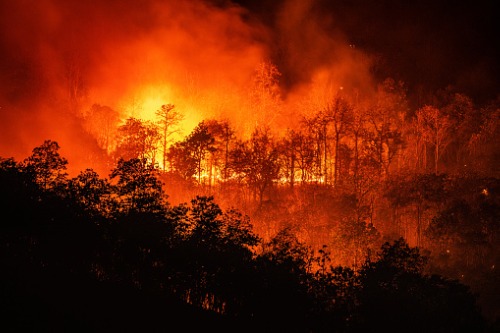

Wildfire is a notably chaotic peril in North America. While Canada has suffered less in recent years than some western regions of the United States, historic events like the Fort McMurray blaze in 2016 and the Slave Lake wildfire in 2011 certainly made wildfire a burning issue for those within the insurance and reinsurance industries in Canada.
In 2020, the country experienced relatively low wildfire activity due to a combination of factors, according to Mark Hope, senior vice president at Guy Carpenter. As of about mid-November, the number of wildfires seen across the country was about 64% of the 10-year average, and the area burned was about 8% of the 10-year average.
“In Western Canada, the numbers were even more remarkably low,” Hope added. “British Columbia experienced about 5% of their 10-year average in terms of number of fires, and 3.4% of their 10-year average of area burned, and Alberta actually saw less than 1% of their average 10-year area burned last year. So, there was relatively low activity across the country in 2020.”
While this reprieve was welcome – especially with people’s attention being held firmly by the COVID-19 pandemic – scientists agree that it was only temporary. Factors like climate change, historic terrain and fire management, population density, and socio-economic development in the wildland-urban interface and intermix areas are only increasing the risk of wildfire in Canada.
Despite the diminished wildfire activity of 2020, the severe incidents of the past several years – of which the Fort McMurray wildfire remains the costliest disaster in Canadian history, with estimated damages of around CA$9.9 billion - have triggered developments in wildfire management.
“That heightened wildfire activity of the past several years has corresponded with an acceleration in knowledge and abilities regarding wildfire risk quantification, structural and community resiliency, and loss modeling capabilities,” Hope commented. “Empowered with this greater understanding of wildfire as a catastrophic peril, the (re)insurance industry will be able to proceed into the 2020s with confidence to be able to make informed decisions and evolve resilience strategies to diminish future potential losses.”
One company to make waves in catastrophic risk modeling is Risk Management Solutions, Inc. (RMS). The firm recently announced its new RMS North America Wildfire HD Models, which simulate wildfire activity across the contiguous Canada and the United States. The probabilistic models capture the full impact of wildfires at high resolution, including the explicit contribution of embers and smoke, thus allowing users to understand the realistic behaviour of wildfires and effectively price locations in and around the high-risk wildland-urban interface.
“Historically, the insurance industry has typically thought of wildfire as one of those attritional loss metrics, something where small losses occur - you lose 100 structures here, you lose 100 structures there – and insurance would pay out and restore those people back to where they were before,” said Michael Young, vice president of product management at RMS. “But as these wildfires get larger and impact larger areas, they potentially start to affect the solvency of [individual] companies and the insurance industry. That’s where catastrophic risk modeling comes in. We take those types of loss trends, and we try and translate those into the fundamental drivers of risk.”
One of the most interesting aspects of wildfire modelling is that you need to account for the human aspects. As Young stressed: “It’s not just a purely natural phenomenon.” Many people think of wildfire as - lightning strikes out in the middle of the forest, triggers a fire and that’s the main driver. But what RMS has found by looking at the statistics in both Canada in the US, is that a large majority of wildfires have a human ignition relationship – either from campfire accidents, industrial accidents, utility risk, and so on.
“One of the key drivers of why wildfire risk is worse today in both Canada and the US is some of the climate change effects that have already occurred,” Young added. “Wildfires are one of those canary in the coal mine type of phenomena that will get worse over time because of the effects of drought and extreme precipitation.”
